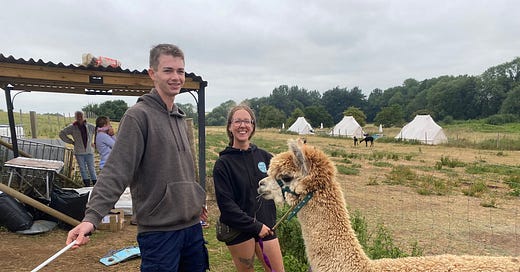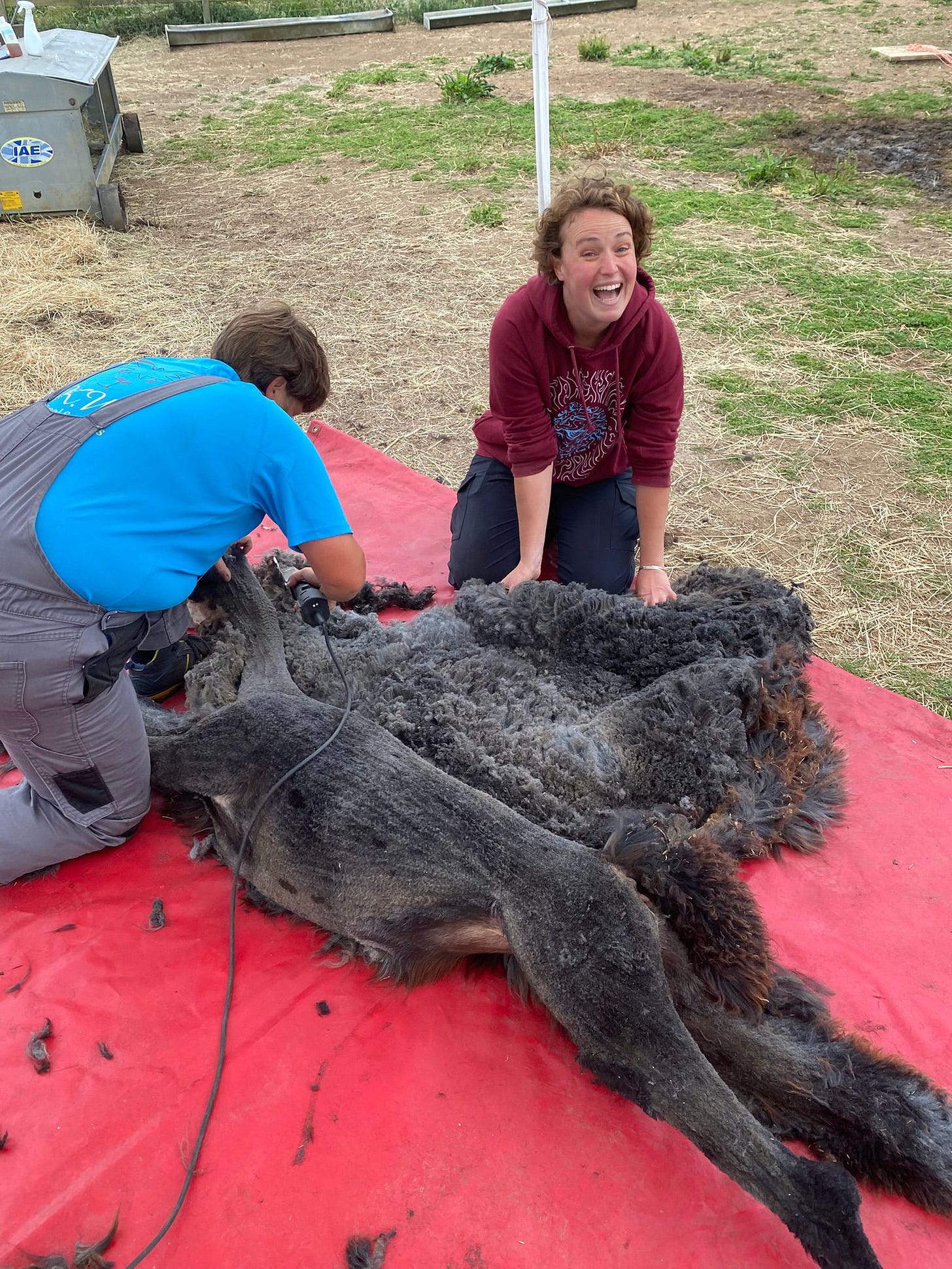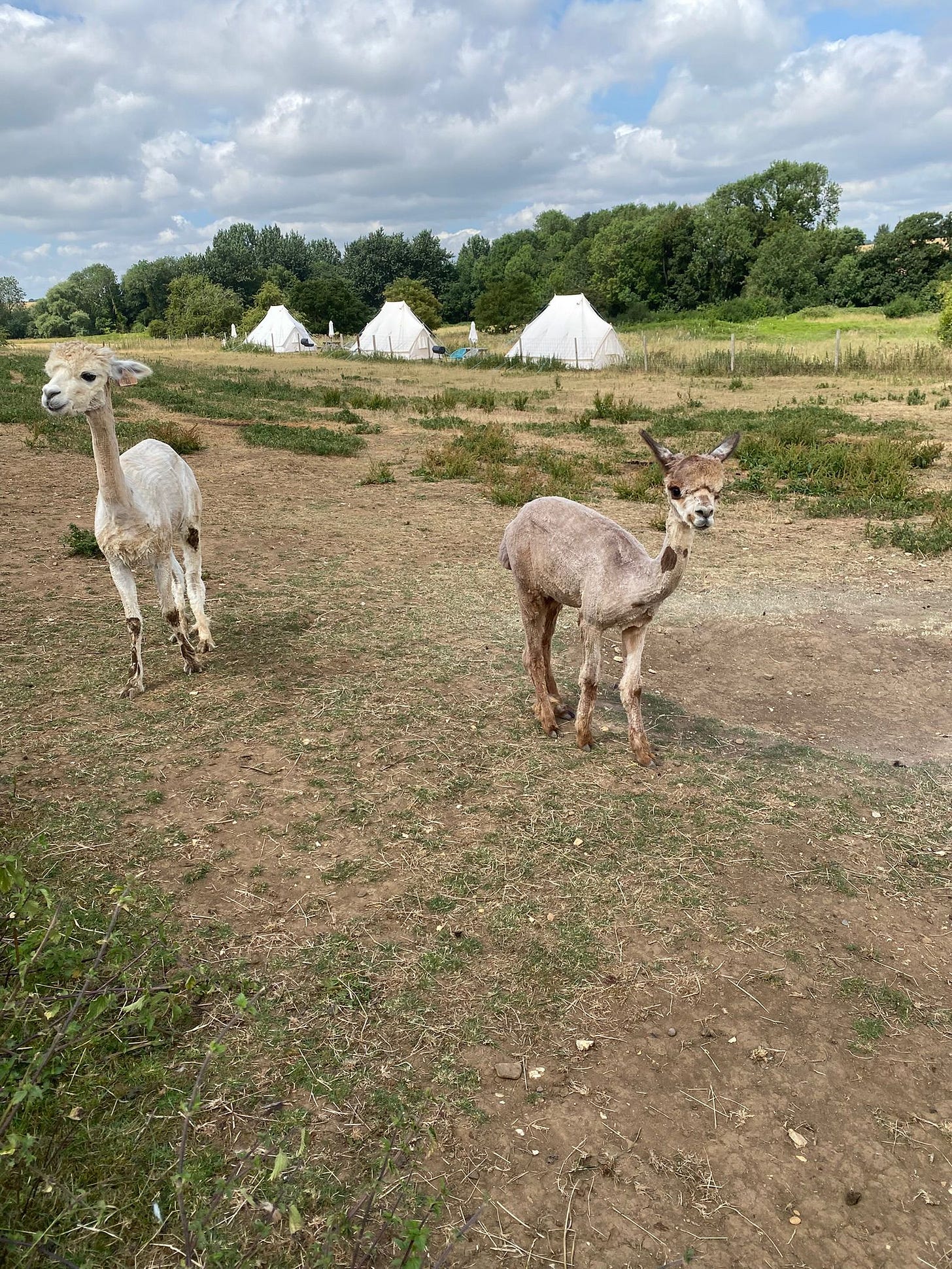Alpaca shearing day at Hideaway Wood Farm
Incorporating a gentle and respectful handling approach to alpaca shearing
Shearing is one of the biggest days in the alpaca calendar and something I, personally, was quite apprehensive about.
Shearing 2024 was the first day of my alpaca apprenticeship, a baptism of fire, so I knew what to expect but having since trained in CameliDynamics I couldn’t help but wonder how we could incorporate a more gentle and respectful approach to the massive task of restraining and shearing thirty four animals in one day. Something I would go on to think about in the middle of the night for about eight months.
Shearing alpacas is different to shearing sheep. You can’t just tip them up and take their fleeces off one handed. Some people hand shear their alpacas without restraint (something I’d love to learn how to do) but for a herd of our size this isn’t viable and so restraint becomes necessary for their safety and ours. At Hideaway Wood Farm we also have the added challenge of three separate groups living in three separate paddocks across the farm which all need to be brought down to the mat at separate times. It’s a big day.
Shearing preparations for me began in the autumn. In big herds its common for many of the animals not to be halter trained and this is true of our herd too. Many had joined our herd without training and getting up to speed is a big job. So I spent much of the autumn and winter using CameliDynamics techniques to accustom as many of our alpacas as possible to contact on and around their faces, ears and top knots before showing them the halter and offering them the opportunity to put their noses into it. I didn’t want shearing to be the only time they had contact with a halter. I wanted them to have positive associations with it.
The next challenge was allowing the alpacas to feel safe in the face of a scary experience on the day itself.
In the face of fear alpacas often go into freeze where they cush to the ground or put on the breaks and flatly refuse to walk, flight where they run, buck, spin, kick and spit.
Because of these responses it’s common industry wide for alpacas to be dragged and lifted onto the shearing mat. This year I had set myself a high bar and it felt totally unachievable. I wanted to walk all thirty four of our alpacas onto the shearing mat, including the most nervous ones.
When alpacas cush the instinct when under pressure in terms of time can be to try to lift or drag them. Not only is this unfair on them, it’s also exhausting and incredibly hard work. My role as handler on the day was to help them to reduce the freeze/flight response by giving them a minute to think - five breaths is usually more than enough. This involves stepping away and giving them space, moving everyone away from the animal and behind their eye to give them access to their escape route and then simply waiting and breathing. Long slow audible exhales are particularly supportive for nervous animals (and for me!). This usually allows them time to think, process and feel safe enough to get up and continue towards the mat.
The next challenge is to get them to step onto an unfamiliar surface. A red tarp may not look like much to us but for animals that spend almost all of their time on grass or mud it’s a scary prospect. (If we’d have had time, training walks where we get them to walk onto the shearing tarp would have been wonderful preparation for the day and something I hope we can do in the future.) Alpacas often put on the breaks just before they step onto the tarp (some before they’ve even left the pen which requires a lot of patience, thought and creativity). Again, the temptation is to continue to try to drag them without a break. As anyone who’s done it will know, it’s actually impossible to pull an alpaca by the lead if they have the breaks on, so this is another time when they’re likely to be lifted. In these moments it’s important to remember that five breaths is not a lot in the scheme of things, especially if we’re running on time and it also helps keep everyone regulated but it’s really hard to remember that in the moment under pressure. Marty Mcgee Bennett (the creator of CameliDynamics) says that when you drag an animal onto an unfamiliar surface they might learn to the trust the surface but they’ve learned that they can’t trust you. I always keep this front and centre of my mind when working with the alpacas (and my child tbh!).
Organisation is absolutely key to buy the time to handle the animals in this way. So for us as a team this meant a couple of planning meetings and a detailed planning document with a run down of the day to the minute. On the day this meant a full briefing with everyone in the core crew around their roles. Kirstie (somehow!) often runs a shearing day with just her and one other. I am in awe. We had an amazing crew of sixteen people supporting us on our shearing day and we couldn’t be more grateful. We couldn’t have done it without this team!
We had the animal handling team, the helping down the mat and neck holding reassurance role, the leg team (looping the feet in the ropes and pulling the ropes to restrain the alpacas and then releasing them again at the end), the collecting and sorting the fleece on the mat role (whilst trying not to get caught with the clippers), the toenail clipping role, the fleece skirting and bagging team, the poo picking in the pen, hay bringing, water trough checking team and of course, the feeding everyone role! Plus a whole team poo picking the rest of the paddocks as we knew we wouldn’t get to that and the show must go on.
We allocated fifteen minutes per animal with animal groups mostly being herded, haltered and moved during the breaks so that there was only ever a small break between animals. And we smashed it! Kirstie's skill and efficiency and the organisation and team work of our crew meant that we finished bang on time! We stepped into the paddock for a briefing with Kirstie at 9:30am and stepped out of the pen at 8:30pm!
I had fretted about this day for months but it ended up being a fun and rewarding (and utterly exhausting) day of hard work and our alpacas are thoroughly enjoying being cool again!
I set a high bar and was expecting to walk away feeling as though I’d let the alpacas down but instead I felt proud. Every single one of our alpacas walked TO the mat and most of them walked onto it. The ones who wouldn’t walk onto the mat only needed a tiny amount of handling to get them there. It was huge and I’m so proud of us for believing it was possible and so grateful to Kirstie to being open to our methods and our team for being the best team ever! The biggest difference I noticed this year was the lack of screaming. They didn’t love it and a few of them really struggled with the experience but the levels of stress were low across the board. This had been my hope and my dream. As a nervy creature myself to see our most nervous girl (Biscuit) walk onto the mat and stay relatively calm throughout was an absolute win for us all.
Many learnings from this year which we will be implementing next year but for now celebrating our success!
Handling techniques we used to keep the alpacas calm on the day:
Mums sheared before babies, babies then follow mums to mat and both are then released minimising separation stress
Most nervous animals, ones likely to scream sheared last to avoid spreading a ripple of anxiety through the herd
Herding and moving with plenty of time so there’s no rush
Turning the generator off when moving groups into pen to reduce stress
Taking time over haltering
Starting to walk the next alpaca to the mat as soon as the previous one is being shorn to give plenty of time to make the journey
Letting them walk off the stress if they want to whilst waiting for their turn
Keeping the herd together as much as possible to avoid separation anxiety
Wand and rope for catching to avoid grabbing and restraint when haltering
Long CameliDynamics style lead ropes clipped to cheek to offer the animal their space and allowing us the most amount of control on the lead
Carly x








